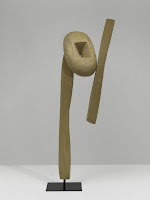

Each work of art in the "Third Mind" exhibition at the Guggenheim Museum, represents a step in a journey, not a destination, as the expression goes. But, even so, I must say, getting to the top of the spiral ramp was quite the culmination to a two-hour trek through the history of contemporary American art.
The point of the exhibition is to show how Asian art and ideas, as co-opted by American artists, influenced the development of a range of modern art American movements from the mid 19th century until now. There's approximately 250 works on display with examples of aestheticism, tonalism, abstraction, calligraphy, minimalism, video and performance art. More than a 100 artists (and writers and musicians) are represented.
Curator Alexandra Monroe says the "Third Mind" [from a William Burroughs Beat work that combines and rearranges texts to create a new narrative] challenges the widely-held view that American modern art evolved from a dialogue with European impressionism, cubism, expressionism and surrealism. Instead, she says imagery and ideas from the East more directly changed Americans sense of nature, existence and consciousness in their art. Seminal American artists, the show points out, even lived and worked in Asia.
(Europeans, though, I would add, also were also influenced by Asian art and ideas. Edouard Manet's 1868 "Portrait of Emile Zola," also flattens perspective and pays tribute to Japanese art. The 2-D surface of the painting is important to Manet, leading to the slippery slope, one could argue, to abstraction, too.)
Nevertheless, what struck me about the "Third Mind" was how the Eastern mindset contributed to changing the relationship between the work of art and its viewer, a bond, of course, still evolving. As time progressed, the ego of the artist as expressed in the work of art begins to disappear, in a manner analogous to the concept of selflessness in Buddhism. With time, the artist's role lessens as the viewer plays a more important part. Of course, as much as the artist "vanishes", he or she never quite escapes.
A viewer, for example, interprets the 1904 photograph of a canal in London, [far left] by Alvin Langdon Coburns as an atmospheric study in shadow and light pretty much as the artist presented it. But the viewer has to work a little harder to understand the white mesh network in Mark Tobey's 1944 "Crystallization" [upper right], even though the tempera paint has been carefully applied (more so than Jackson Pollock's paint drippings).
Isamu Noguchi's 1959 "Cry," [bottom left] seems to have elements of an open mouth in a crying face, perhaps an upraised arm in pleading, too. But that is purely my "vision" of the sculpture. Ultimately, with John Cage's 1952 4'33'' silent symphony, the ambient sound of the audience and the environment becomes the performance.
That dialogue between artist, work of art, and viewer obviously continues today. James Lee Byars"The Death of James Lee Byars," 1982/1994, [bottom right], one of the first pieces in the show, is a room you enter to live in the present moment, the audioguide says. It is a gold-leaf covered monument to the transitory nature of life and its ultimate demise. The artist would come into room, lie down on the altar and leave behind crystals. Although the gold leaf is peeling in some places, perhaps to mimic decay, the overall effect is still quite impressive. The ego of the Byars, like that of the pharoahs in Egypt, is quite apparent, even if the ephemeral nature of life is the theme.
Interestingly, the last "stop" in the ramp in the "Third Mind" brings you back to the main floor, by way of an installation piece by Ann Hamilton, commissioned by the Guggenheim for the exhibition. In the work, Tibetan bells follow a winding track along the walls of the Guggenheim's rotunda, ringing intermittently along the way. At the bottom floor, behind a curtain, the bells bang into a bunch of waiting cut-up books, which then plop to the floor. An attendant on the top floor, then pulls up the bells and hoists down more books for the process to start again. The piece, Hamilton says, represents a visual metaphor for the process of "reading, which leaves no material trace but which might forever change you."
Without the explanation, I thought Hamilton's work was about trying to use a symbol, the bells on the track, as a way to integrate the works in the exhibition into a whole, which is possible--the curator did it--and impossible--so much to absorb. I think my"interpretation" is consistent with artist's explanation and with curator's intent for this show. Monroe has imposed a powerful paradigm on the many disparate works in the exhibition. She has changed the way I will forever look at these artists' works and other current modern art, which, without question, owes a lot to these predecessors.
(Images courtesy the Guggenheim Museum. Alvin Langdon Coburn, "Regent's Canal, London," 1904, Photogravure print, 21.6 x 17 cm, George Eastman House International Museum of Photography and Film, Rochester; Mark Tobey,"Crystallizations," 1944 Tempera on board, 45.7 x 33 cm Iris and B. Gerald Cantor Center for Visual Arts at Stanford University, Mabel Ashley Kizer Fund, Gift of Melitta and Rex Vaughan, and Modern and Contemporary Acquisitions Fund © Mark Tobey Estate/Seattle Art Museum Photo: M. Lee Fatherree Photography; Ismau Noguchi, "The Cry," 1959, Balsa wood on steel base, 221 x 85.1 x 47.6 cm including baseSolomon R. Guggenheim Museum, New York66.1812© 2009 The Isamu Noguchi Foundation and Garden Museum, New York/Artist Rights Society (ARS), New YorkPhoto: Kristopher McKay, The Solomon R. Guggenheim Foundation, New York; James Lee Byars," The Death of James Lee Byars," 1982/1994Gold leaf, crystals, and PlexiglasDimensions variableVanhaerents Art Collection, Brussels, Courtesy Marie-Puck Broodthaers, Brussels© Estate of James Lee ByarsPhoto: Courtesy of Michael Werner Gallery, New York and Cologne, and the Estate of James Lee Byars.)




No comments:
Post a Comment